Bali and Lombok
General
Bali is an island and province in Indonesia. Lombok is usually called "the island next door". Both are in the Coral Triangle, an area known as the Amazon of the Oceans. Although this triangle has only 1.6% of the planet's oceanic area, it contains 76% of all known coral species in the world, and 37% of all coral reef species. It is the global centre for marine biodiversity and a global priority for conservation. And Lombok's Gili islands are world famous.
In short: snorkeller's paradise.
Indonesia gained independence from the Dutch in 1949, and since then has gone through five different phases of government. The current system is complex, and involves parties with more than 20% of parliamentary seats nominating a presidential candidate, who is then directly elected by the people, for a five-year term. The fourth such election was held in 2014.
Bali suffered terrorist bombings in 2002 and 2005, but respective governments have relaxed their security warnings since then. The UK Foreign Office advises caution for a number of reasons, including the November 2017 eruption of ash clouds from Mount Agung in East Bali.
Around 330,000 British nationals visit Indonesia each year. https://www.gov.uk/foreign-travel-advice/indonesia.
The islands are just 8 degrees south of the equator, and have an average 30˚C temperature all year round.
Currency: Indonesian Rupiah.
10,000 Rp = £0.55. = €0.62 = US$ 0.70
Flight time London to Bali: 16 hrs 15 min. No direct flights are available. You have to go via Singapore, Hong Kong, or a number of other places.
Time in Bali and Lombok: UTC+ 08.00
Entry requirements: valid passport, return ticket.
Visas? The visa system is complex. Essentially, if you are going as a tourist for less than 30 days, you get a free visa stamp on arrival: but you need to check if your country applies. US and EU are OK. If you want to extend your stay or arrive as other than a tourist, different systems apply.
See https://www.bali.com/visa-indonesia-entry-requirements-bali.html
Written November 2017
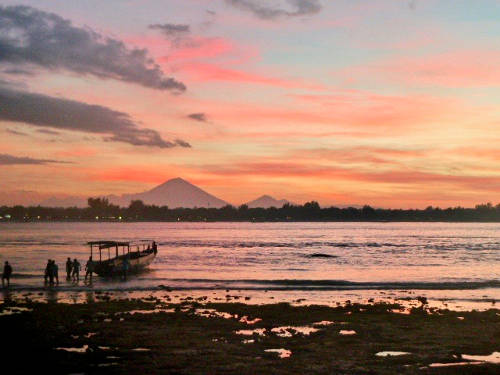

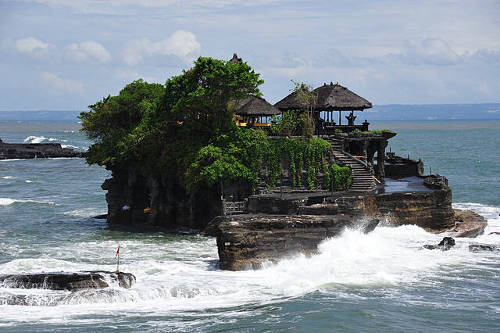
Climate charts (for Denpasar, Bali)
As you can see from the charts, there's a big difference between the rainy season (October to March) and the dry season (April to September). Bali gets most visitors in July and August, so if you want cheaper prices, April, May, June and September are better. During the rainy season, the sea is rougher and the beaches get debris on them. And it can rain, a lot. This site is very helpful: https://www.bali.com/news_weather.html
If you want to check sea temperatures: https://www.seatemperature.org/asia/indonesia/banjar-bali-january.htm
Lombok is two hours away from Bali by boat. It has much the same climate, though it is drier in the rainy season. Both places are humid, and, being close to the equator. have twelve-hour days and twelve-hour nights. http://www.world-guides.com/asia/indonesia/west-nusa-tenggara/lombok/lombok_weather.html.
Expect really hot sunshine. Wear sun protection.
UK Foreign office says there is a risk of Zika virus and dengue fever. Mosquito protection is a good idea.
Sea temperature - 26°C to 29°C all year round (that’s warm).
Bali is in the centre of the map, with Denpasar airport to the south. Menjangan is in the western tip (coloured green). The island is north of Taman Nasional Bali Barat. Lombok is on the right, with the three Gilis off the north-west coast, north of Pamenang.
Bali
Bali can be really hot, so check the climate before you book. We went in May/June, which was fine - 32 degrees and just before the High Season.
With a population of 4 million, it can be busy, but 80% of its income comes from tourism so it welcomes visitors. It's a Hindu island, and you see shrines all over the place: most homes have one. The island has a reputation as a party place for Australians, but it's not just loud music and alcohol. There are some idyllic quiet places and the snorkelling is wonderful.
Charles Anderson's book, An underwater guide to Indonesia, gives a good overview. No one knows how many fish species there are in Indonesia, but it's reckoned there are more than 3,000. For comparison, just 1,250 species can be found in Europe. The whole of the Caribbean has 50 reef-building coral species. Indonesia has 450.
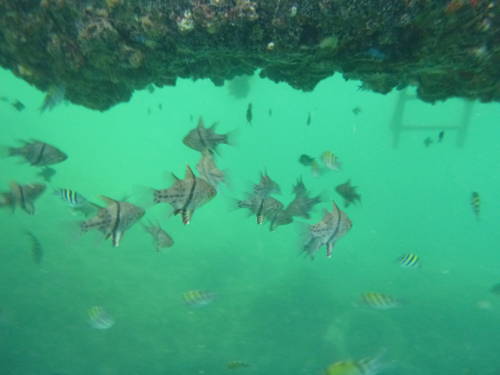
Bali is paradise: hot, blue sea, green forests, smiling people. It's a long journey from the UK. 12 hours to Singapore, a three-hour flight to Bali. We were in Menjangan, in the Taman Nasional Bali Barat (the national park) in the north-west of the island, a four-hour road trip from Denpasar.
It was worth it when we got there. The modern beach villas are five metres from the sea, and the Menjangan Resort has a floating pontoon jetty onto the house reef. Visibility is good, especially in the morning, the reef is pristine and unspoiled, sea temperature 26 degrees, a lot of marine life to keep you occupied every time you go in. We saw lion fish, morays, parrotfish, pipefish, chromis, the usual butterflyfish - masked, spotted, panda. Lots of fish around.
An interesting feature of Indonesian snorkelling is that the Indian Ocean to the west meets the Pacific Ocean to the east. A naturalist called Wallace first noticed that you get certain species in the eastern islands that don't exist in the west, and vice versa. He came up with a frontier between Bali and Lombok and called it Wallace's Line to distinguish the two zones.
Later naturalists saw that the distinction was more blurry than linear and called the whole area Wallacea, but in practice it means that you get different varieties of the same species co-existing as 'sibling species', which makes for an even wider variety of fish life. The damselfish known as sergeants or sergeant majors, for example, come in two or three types, with the washed-out looking Black-Tail Sergeant being very common.
Slow snorkelling off the jetty at Menjangan is particularly fruitful, with striped catfish forming small balls, yellow box fish, cornet fish, hump head banner fish, black-tailed dascyllus, and the weird many-finned fish that live under the jetty - the orbicular Cardinalfish. The shallows operate as a nursery, with a good deal of small fishes and some larger ones. On the Red Sea index, we'd give this a 9 out of 10.
"The important thing to remember about our country is that we believe in balance," says the driver as we approach the Bridge Rd. "Everything in the world has good or bad in it. The good comes from the sky, the bad from the ground. White is the colour of good, black is evil. But you need them both. Trees have this balance. And animals. And humans too."
We hit the main road and ease into the swarm of traffic. Jalan Tjampuhan is full. Motorbikes, scooters, SUVs, vans, their headlights all slicing through the city dark. Ubud is now the second biggest town on the island, and everyone is coming in for the evening. Two streams of vehicles meld into one in baffling chaos with an almost telepathic result. I can't work out how they do it. They just seem to know.
"There are four and a half million people in Bali, and two million temples," he continues, steering round a scooter with four people on it. " We have village temples, family temples, temples for professions. I go to the temple twice a day to make offerings to the gods."
"Where is your temple?"
"Everywhere."
The snorkelling books recommend a trip to Menjangan Island, which has world-renowned diving and snorkelling, so of course we took a trip there from the hotel - $US 45 per person, with an extra $10 if you book lunch. It takes about thirty minutes.
We did two one-hour snorkels, the first a drift snorkel along the north-east of the island, with excellent visibility, and loads of fish - morays, batfish, parrotfish, lion fish, anenome fish. We followed the line of a cliff in a reasonable current that was too strong to swim against for long. We looked for ghost pipefish among the beautiful feather stars, with no success. Two people felt seasick because of the current, and one threw up.
After that we did another snorkel along the cliff that fronts the jetty that fronts the island. This was truly spectacular, with a plummeting rock face that entertained hundreds of different species which got larger as the cliff got deeper.
This was a stunning snorkel marred only by the fact that hundreds of other people had the same idea. There must have been forty boats all moored up together, and the snorkel was a tangle of arms, legs and fins.
It was a real problem - one of the most stunning snorkel locations we'd seen in a long time, but with a lot of the shine taken off by the crowds.
We drive down the hill towards the river. Suddenly, in front of the car, I see a shape moving into the road. It's not something I've seen in a road before, but it activates generations of fear and instinct. I'm surprised by the speed of my reaction. "Snake!" I shout. There are more than 40 species of snake here, six of them poisonous. The pit viper has the worst reputation, but the spitting cobra needs occasional thought too.
The driver slams to a halt. Over the car hood, I can see the snake writhing in the road. It's a tormented dance, a forcing pirouette with its head a foot above the surface of the tarmac. Heads, actually. There are two snakes in a writhing double helix. It's surreal. I'm looking over the driver's shoulder at two snakes making love, vertically, in a city street in the headlights of a shuttle car.
There's an additional complication. The shadows cast by our headlights give them an extra two heads. It looks like four snakes are performing a bizarre dance two metres in front us. The traffic has stopped in both directions. Drivers are half out of their vehicles, watching this bizarre performance in a small arena formed by car headlights.
"They're fighting!" says Gill.
"No, they're not fighting", says the driver. Having to explain this kind of thing is proving difficult to his tourism vocabulary.
The boats all leave their start point at about 9 am because the visibility is best in the morning, but it means that everyone arrives at about 11 and it's heaving. The books say there are six or seven good snorkel points around the island, but the drivers all head for this one because you can land the boat there and have lunch.
We kept slow snorkelling by the jetty, and were rewarded with a number of interesting fish - the 'Who the fuck are you?' fish by the branched red coral (never identified this one - it took up a very aggressive stance every time we came up, and it was a very small fish...): the barred rabbit fish, and, my particular favourite, the yellow fox-faced rabbit fish.
Checkerboard wrasse, diamond fish under the jetty, and, in the shallows, a bristle-tailed filefish doing a perfect imitation of a leaf. Wonderful place...
A scooter comes racing round the side of the car and swerves to avoid the writhing mass. Our driver is out of our car shouting abuse at him. Our Balinese stretches to "How are you? Four beers please. That's delicious", and "Thank you" but we can understand that our driver is giving the unfortunate scooter rider a ferocious telling-off. He looks suitably abashed. And, for a moment, there's a stand-off.
We maintain the circle round the serpent sex scene. Everything has stopped except for the main participants. In the USA or Australia these snakes would be dead by now, crushed under wheels and mangled until they are flat. Here, everyone holds their breath and waits.
A driver in the car facing us takes a rag from his front seat and flings it over our main players. They keep coadunating under the newly-acquired but partially covering duvet. Their bodies writhe and glow in apparent ignorance of hundreds of spectators.

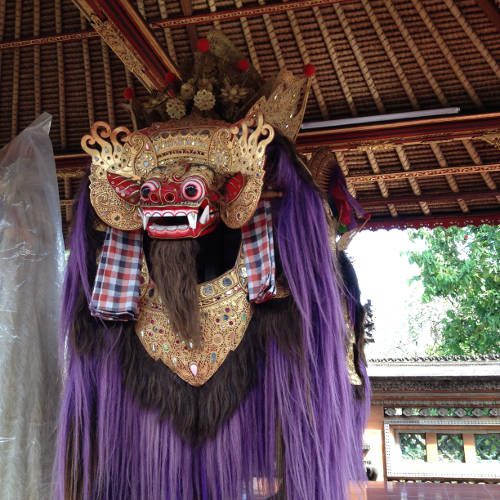
Suddenly a scooter driver parked on the pavement in front of us does a remarkable thing. He steps upright in his scooter, reaches down to his T shirt and pulls it over his head. His back and upper torso look pale and helpless in the car headlights. Is he going to scoop them up in his shirt? That really is dangerous. Most snakes leave you alone if you leave them alone. Start interfering with them, however, and you get into serious trouble.
He whips the shirt around his head in a Wild West lariat movement and throws it into the road, over the snakes. Now they're puzzled. It's a navy blue shirt and everything's gone dark. They pause for a moment. You can almost see "WTF?" hovering over their heads.
Our driver takes his chance and steers round the suddenly still scene. He's remembered he has to get us to the Barong Dance - the Balian commemoration of Good versus Evil.
"Will the snakes be OK?" we ask.
"Oh yes," he says, "They will be fine."
"Why were those people throwing their T shirts over them?"
"Ah," he says. "Here we believe, if your shirt is touched by a snake, it's good kris for the rest of the day."
"Kris?"
"Luck. If a snake touches your shirt, but you are not hurt, it's very good luck. You are going to have a good day. A very very good day."
Lombok and the Gilis
After five days, we left to check out Ubud, the cultural centre of the island, then travelled on to the Gili Islands. These have a world-wide reputation for diving, especially if you want to see green turtles. Getting there involves a small flight from Bali to the next-door island of Lombok, a two-hour drive, and a fifteen-minute speedboat ride - though there are fast speedboats from Bali to the Gilis.
Lombok has a population of about 3.5 million, perdominantly Muslim - so there is a great difference in the cultural landscape. Mosques, not temples. It's poorer than Bali but hospitable, beautiful and friendly.
The Gili Islands
There are three Gili Islands off the North-west corner of Lombok, north of Pamenang - Gili Air, Gili Trawangan, and Gili Meno (Gili means 'Island': strictly speaking, there are more than 30 Gilis off Lombok, but these the three that attract snorkellers).
The first two have the reputation of being party Islands, so we stayed on Gili Meno - a charming small isle that you can walk around in two hours, that doesn't have cars, using horses and carts instead, but does have dive shops and an ATM.
We did a lot of snorkelling here, in varying conditions of visibility. One of the things you should be aware of is that there is only one high and one low tide here, so if you want to go out at low tide you will probably need to wear boots or fins, as the stones can be sharp. There is a law forbidding the collection of dead coral.
The Mahamaya Hotel on the west coast of Gili Meno has a walk-in reef and a lot of turtles. We saw a turtle almost every time we went out, and the hotel was great.
Boat trips
We spent mornings and afternoons snorkelling from the hotel, though we tried a couple of boat trips - once round Gili Meno, and next to nearby Gili Air. Visibility changes daily, and is often better in the morning. When visibility is good, this is a stunning place to snorkel. When visibility is poor, swimming further out can sometimes help.
Some operators offer three-island trips, going to some of the places we visited on Gili Meno and Gili Air, plus two more on Gili Trewangan. We didn't do this.
One final thing - tickets on the large glass-bottom boats can be expensive, compared to hiring a boat for yourself. If there are four of you, prices per person can be roughly equal.
Here's a diary of the stay (the reference book we used was Reef Fish Identification - Tropical Pacific (New World Publications)).
Sunday 31 May 2015
- Humpback unicorn fish (long horn - adult male) p 54
- Black patch triggerfish p 407
- Pink tail triggerfish p 408
- Titan triggerfish p 404
- Oriental sweet lips (juv/ sub adult) p 170
- Fine-lined surgeonfish or Orange socket surgeonfish
- Indian parrotfish? P 175
- Saddled butterflyfish p 24
- Monday 1 June 2015
- Rainbow runner - p 127
- Latticed butterflyfish - p 21
- Pale-tail chromis - p 83
- Gold-belly damsel - p 92
- Pink tail triggerfish - p 408
Some cultural notes
Bali is predominantly Hindu, and they speak Balinese. Lombok is mainly Moslem, and they speak Sasak. Both understand Indonesian, sometimes called Bahar Indonesian, so if you want to learn a few words, this is the best place to start. The best book we could find was Essential Indonesian, by I.P.Nugraha and K. Ingram, published by Tuttle Publishing.
- Hello. Halo.
- Good morning. Selamat pagi.
- Good afternoon. Selamat siang.
- Good evening. Selamat malam.
- How are you? Apa kabar?
- Fine - and you? Beik - dan Anda?
- Pleased to meet you. Senang bertamu denang Anda.
- One, two, three, four. Satu, dua, tiga, empat.
- Two beers please. Dua bira. (Please isn't used for this)
- Water. Air (pronounced Ayeer)
- Coffee. Copi.
- Juice. Jus.
- Thank you. Terima Casi.
- Thank you very much Terima Casi Banya.
- Can I have the bill? Poli saya minta bil?
- Can I order..... Poli saya order.....
- Salt Garam
- Pepper. Lada hitam
- Sugar. Gula
- Where is... Di mana...
- Delicious. Enak
Tuesday 2 June 2015 (boat trip round Gili Meno. Booked through Mahamaya Hotel -650,000 rupiah, or £35. Started at 8.30 am, finished at 11.30. About 10/ 15 minutes each stage of the boat trip). Route - ( the spots have different names, so we'll give locations too.)
- 1. Coral garden,or Meno Reef, south of island. Exquisite corals.
- 2. Meno reef, east of island. Saw a turtle.
- 3 Simon reef, North-East of island. Saw two turtles in concrete blocks at sea bottom.
- 4 Meno wall, North-west of island. Saw two turtles, followed them to open sea.
- 5 Bounty wreck, South-west of island. This is an old sunken pontoon, with good fish life, but very popular with snorkel boats. By the time we saw it (11 am) it was very crowded.
Turtles seem to gather on the west side of the island. The Mahamaya Boutique hotel was extremely pleasant with helpful staff who are very knowledgeable about snorkelling. Boats are all organised by a local cooperative, and work out at about £10 an hour. Agree the price before you start.
3 June 2015
- Black patch triggerfish p 407
- Pink tail trigger fish p 408
- Black spotted puffer fish (variation) p 416 dark above / yellow under
- Bird wrasse (IP) p 208
- Unicorn fish (blue spine?) p 54
- Orange band surgeon fish p 45
- Oval spot butterfly fish
- Five green turtles
- Shoal of white fish-shaped fish with black bars and stripes on backs? (Thought it might be checkered snapper, p107, but it isn't, or monocle bream, p 115, but wrong location)
Thursday 4 June 2015
- Raccoon butterflyfish p 21
- Convict surgeonfish p 50
- Striped surgeonfish p 48
- Spotted box fish - male p 394
- Fine-lined surgeon fish p 49
- Big scale soldier fish (p241) or similar - the big-eyes are very shy.
- Snowflake moray p 436
- Chevroned butterflyfish p 17
- Trumpetfish p 401
- Cornet fish
- Blue streak cleaner wrasse IP - p 237
- Three-striped whiptails? P 112
Friday 5 June 2015. Went on the boat trip with Riza and his uncle.It was our second Gili boat trip - to explore Gili Air. 700.000 Rupiah (£35). Picked up at 08.15
- First stop - Bon Cache, south of Gili Air. Good coral, biggest we've seen.
- Second stop -opposite Sunrise, on East Coast of island. Strong current, so we drift dived from north to South. Current too strong to swim against without fins. Clear water, good coral, lots of fish, though mainly quite small.
- Third stop - opposite North-west corner of island. Saw a turtle. Gill saw lots of small fish leaping into the air in shoals, being chased by a bigger fish, probably a barracuda. As the fish leapt into the air, two sea birds arrived, and started catching them at the top of their jumps.
- Verdict on Gili Air - nice coral, good visibility, clear waters, strong currents, variety of fish but not too many big ones.
- Bridled monocle bream p 113
- White-tailed Pygmy angelfish p 35
- Bicolor angelfish p 33
- Powder blue surgeonfish p 47
- Masked rabbit fish p 56.
- Green turtles (three)
- Checkerboard wrasse p 218
There are another three pages of this. You've probably had enough...
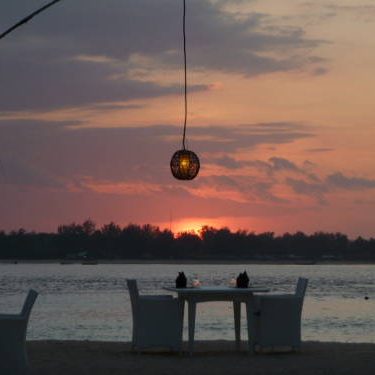
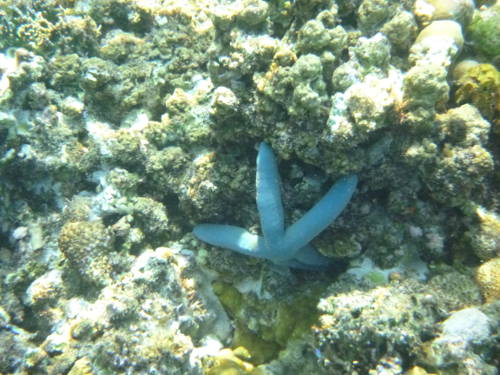
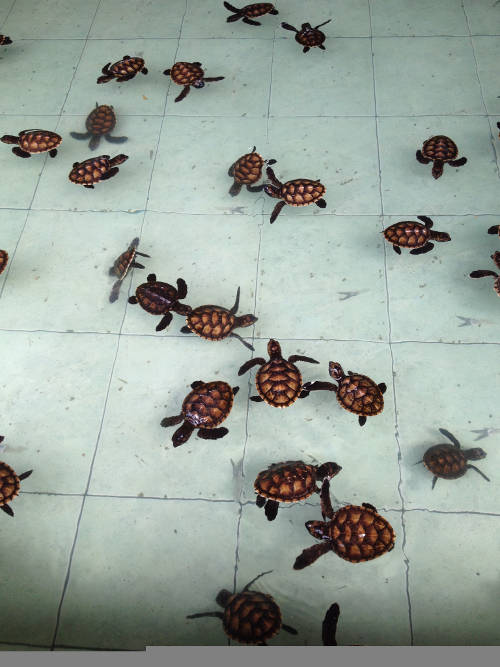

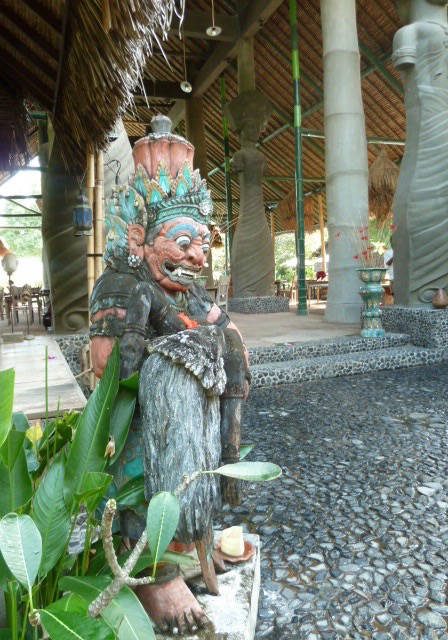
Lombok
Finished off the trip by going to Lombok, and saw a Horned Star Fish, also known as a Chocolate Chip Cookie star fish.
Stayed at the exquisite Tugu Lombok, a wonderful hotel that boasts its own reef - but there has been commercial exploitation here, the reef is badly degraded and you need to swim out 300 metres or use the hotel kayaks to get to the snorkelling raft moored quite a way out. Once there, the reef is pretty good, with the usual suspects and some interesting coral.
We watched a White Sea snake / eel looking in holes for fish, being confronted by a small wrasse which tried to bite its head off. The snake retreated, and after being pursued again, raced off along the sand. On the way back, Gill saw what looked like a poppy on the sea bed - it was the egg ribbon of a Spanish dancer sea slug, Hexabranchus Sanguineus. . The bright red is a warning not to eat.
We went out again this afternoon, walking along the beach to where the reef is closer to shore. Monumentally beautiful corals towering alone in the sand like huge bushes under seas, very beautiful and, in their isolation, rather unusual. We saw an eighteen-inch cuttlefish, the biggest we've ever seen, and Gill spotted a vermiculated angelfish.
Would we go there again? Absolutely! But it's a long way away and we might not get the chance. We would probably choose May, June or September.
Useful links:
https://www.lonelyplanet.com/indonesia/bali
https://wikitravel.org/en/Bali
http://www.balitourismboard.org
https://www.gov.uk/foreign-travel-advice/indonesia
https://www.lonelyplanet.com/indonesia/lombok
https://wikitravel.org/en/Lombok
https://www.theguardian.com/travel/2011/may/15/lombok-indonesia-beach-holiday
http://www.indonesia.travel/gb/en/destinations/bali-nusa-tenggara/lombok

Usual warning: we have made every effort to make sure this information is correct and up-to-date, but you need to check it all yourself.
© Garreg Lwyd Ltd 2018
Do you have any comments, or recommendations? Send us a message! We'd love to hear from you...
